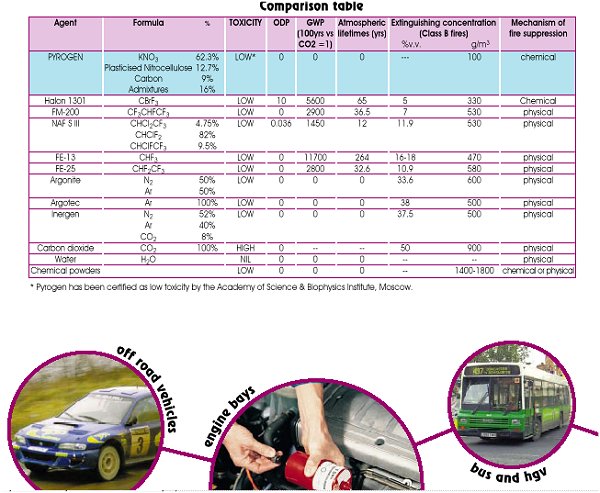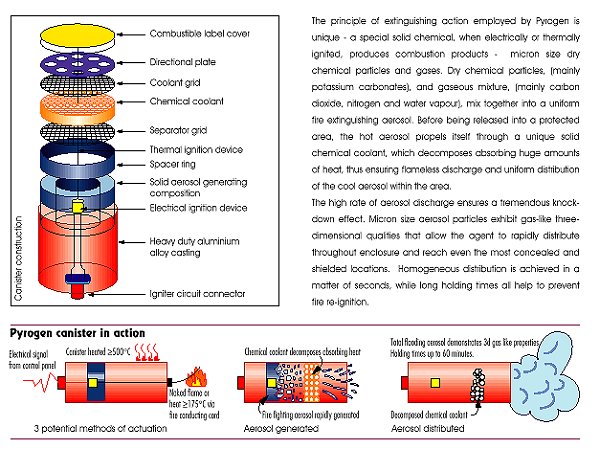The secret to Pyrogen's'
power is in two unique formulations contained in Pyrogen canister -
the solid aerosol-generating
chemical and the solid chemical coolant.
The
solid aerosol-generating chemical is a thermoplastic mixture consisting
of an oxidizer, a
combustible binder and
technological additives. The oxidizer is a solid potassium nitrate
(KNO3(s)), the combustible
binder is a solid plasticized nitro-cellulose (CnHmNpOq(s)) and
technological additives include
carbon (C(s)) as an activator of the oxidizer's decomposition,
chemical and mechanical stabilizers
and some other ingredients.
When ignited the solid-generating chemical undergoes a combustion reaction,
which can
schematically be represented
as follows:
KNO3 (s) + CnHmNpOq (s) + C(s) = KHCO3
(s) + K2CO3 (s) + CO2 (g)+ N2(g) + H2O (g)
As
the reaction temperatures are high, potassium carbonates are formed in
the gas phase,
but as the vapor cools, the
potassium carbonates condense to a liquid and then a solid. As solid
potassium carbonates are
produced by condensation, the particle size is very small -
approximately 1 micron. Micron
sized solid particles mix with the gaseous carbon dioxide,
nitrogen and water into a
uniform homogeneous gas - like phase - an aerosol.
Thus, Pyrogen extinguishing aerosol is a suspension of the micron sized
solid particles,
mainly potassium carbonates,
in the gas mix of carbon dioxide, nitrogen and water vapor. Being
a combustion product of the
aerosol-generating chemical, Pyrogen aerosol is hot upon
formation. Although, Pyrogen
aerosol is the most effective in terms of the actual fire
extinguishment when in its
hottest state, the negative impacts of very high temperatures are
obvious. Ejection of flame
at the discharge outlet and poor distribution within a protected
enclosure is the main of
those impacts and should be eliminated. When the hot Pyrogen aerosol passes
through the coolant, the coolant decomposes absorbing a great amount of
heat.
Pyrogen chemical coolant is a polymer composition highly impregnated with
endothermic
ingredients - substances
that decompose at 200-300 ° C without melting, generate
gases and
absorb approximately 400
Cal of heat per one kilogram of their mass. Cooling is effected at a
fantastic rate of 400 degrees
per second.
Application of the Pyrogen coolant enables the arrest flames at the discharge
outlet and
provides uniform distribution
of the aerosol within the area, which certainly contributes to the
reliability and safety of
the extinguishment. Moreover, additional amounts of inert gases are
formed due to a thermal decomposition
of the coolant, which contribute to the effectiveness of
the extinguishment.
in other words Pyrogen "chemically
extinguishes fires", holds down reignition
"NOT JUST BLOW THEM
OUT MECHANICALLY"







-
HOME
US EPA, SNAP, ISO, ICAO, FAA US DOT,
NFPA, SAE, FM, NIST, ATA, UL, SSL, AS/NZS, ODP , GWP , Pyrogen , PYROGEN
, Airline Cargo conversions , Class A fire , Class B fire , Class C fire
, EMAA, Encapsulated Micron Aerosol Agent, FAR 25. Aircraft Cargo Fires,
Telecommunications fires , Transportation fires , Petrol chemical fires
, Fire detection, Automobile Fire , Truck fires , Train fires , Building
fires , Structural fires , petroleum fires , engine fires , marine fires
, cargo fires , wood fires , Halon flooding , UL 1058, aircraft fire protection
, aircraft crash , airline cargo fire , airline fire protection , FAA Technical
center , Oil rig fires , gas rig fires , vehicle fires , electrical fire
suppression , computer room fires , ship fires , machinery fires , merchant
vessel fires , train fires , generator fires , battery fires , Wheel fires
, brake fires , tire fires , car fires , home fires , Loss productivity
, boeing fire test , 737 fire test , NRL , Naval Research Laboratory
, Naval air systems command , NASC , NAVAIR , AS/NZS 4487:1997 ,
Joint strike fighter , JSF, HARC , NTSB , Transport canada , NIST , FAA
Technical Center , Thermal Acoustic Insulation Blankets , IMO , International
Maritime commission , USCG , United states coast guard , MCA , Pyrogen
Ltd. Pyrogen Corp. Sdn. Bhd. , IAFC , IFPA ,
fire protection systems , Halon replacement
, fire Suppression , fire suppression systems , fire extinguishers
, fire science, flame management, US EPA, SNAP, ISO, ICAO, FAA US DOT,
NFPA, SAE, FM, NIST, ATA, UL, SSL, AS/NZS, ODP , GWP , Pyrogen , PYROGEN
, Airline Cargo conversions , Class A fire , Class B fire , Class C fire
, EMAA, Encapsulated Micron Aerosol Agent, FAR 25. Aircraft Cargo Fires,
Telecommunications fires , Transportation fires , Petrol chemical fires
, Fire detection, Automobile Fire , Truck fires , Train fires , Building
fires , Structural fires , petroleum fires , engine fires , marine fires
, cargo fires , wood fires , Halon flooding , UL 1058, aircraft fire protection
, aircraft crash , airline cargo fire , airline fire protection , FAA Technical
center , Oil rig fires , gas rig fires , vehicle fires , electrical fire
suppression , computer room fires , ship fires , machinery fires , merchant
vessel fires , train fires , generator fires , battery fires , Wheel fires
, brake fires , tire fires , car fires , home fires , Loss productivity
, boeing fire test , 737 fire test , NRL , Naval Research Laboratory
, Naval air systems command , NASC , NAVAIR , AS/NZS 4487:1997 ,
Joint strike fighter , JSF, HARC , NTSB , Transport canada , NIST , FAA
Technical Center , Thermal Acoustic Insulation Blankets , IMO , International
Maritime commission , USCG , United states coast guard , MCA , Pyrogen
Ltd. Pyrogen Corp. Sdn. Bhd. , IAFC , IFPA ,


![]()
![]()
![]()
![]()
![]()